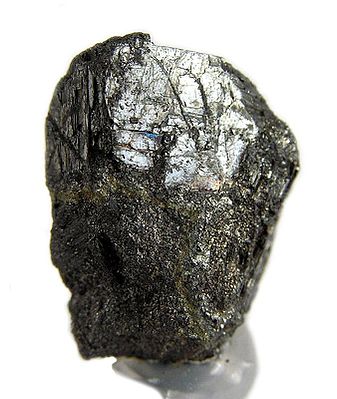Aramayoite
| Aramayoite | |
|---|---|
| Aramayoite stage from the “Animas Mine”, Atocha-Quechisla, Sur Chichas, Potosí, Bolivia | |
| General and classification | |
| chemical formula | Ag (Sb, Bi) S 2 |
|
Mineral class (and possibly department) |
Sulfides and sulfosalts |
|
System no. to Strunz and to Dana |
2.HA.25 ( 8th edition : II / C.16) 07/03/04/01 |
| Crystallographic Data | |
| Crystal system | triclinic |
| Crystal class ; symbol | triclinic-pinacoidal 1 |
| Space group | P 1 |
| Lattice parameters |
a = 7.76 Å ; b = 8.85 Å; c = 8.23 Å α = 100.2 °; β = 90.7 °; γ = 103.8 ° |
| Formula units | Z = 6 |
| Physical Properties | |
| Mohs hardness | 2.5 |
| Density (g / cm 3 ) | measured: 5.602; calculated: 5.88 |
| Cleavage | completely after {010}, clearly {100}, indistinct {001} |
| Break ; Tenacity | uneven |
| colour | iron black |
| Line color | red-brown to black-brown |
| transparency | opaque |
| shine | Metallic luster |
Aramayoite is a rarely occurring mineral from the mineral class of " sulfides and sulfosalts ". It crystallizes in the triclinic crystal system with the chemical composition Ag (Sb, Bi) S 2 and develops up to one centimeter large, silver-metallic shiny , but otherwise iron black, thin tabular and along {100} and {001} striated crystals .
Aramayoite crystals are almost opaque , but can shine through dark blood red at the corners of very thin layers. The color of the streak is red to black-brown.
Etymology and history
Aramayoite was first discovered in 1925 in the "Animas Mine" near Atocha- Quechisla in the Bolivian Department of Potosí and described a year later by the English mineralogist Leonard James Spencer (1870–1959), who named the mineral after the Bolivian mine owner Don Felix Avelino Aramayo (1846 –1929) named.
classification
In the now outdated, but still in use 8th edition of the mineral classification according to Strunz , the aramayoite belonged to the mineral class of "sulfides and sulfosalts" and there to the department of "sulfides with the molar ratio of metal: sulfur, selenium, tellurium = 1: 1", where together with Baumstarkit, Bohdanowiczit , Cuboargyrit , Matildit , Miargyrit , Schapbachit and Volynskit formed an independent group.
The 9th edition of Strunz's mineral systematics , which has been in effect since 2001 and is used by the IMA, also assigns aramayoite to the class of “sulfides and sulfosalts”, although there it belongs to the department of “sulfosalts with SnS as a model”. This section is further subdivided according to the cations involved in the chemical structure , so that the mineral can be found according to its composition in the sub-section “With Cu, Ag, Fe (without Pb)”, where it is only the unnamed group together with Baumstarkit 2.HA.25 forms.
The systematics of minerals according to Dana also assigns the aramayoite to the class of "sulfides and sulfosalts" and there in the department of "sulfosalts". Here he is also together with Baumstarkit in the unnamed group 07/03/04 within the subsection " Sulphosalts with the ratio z / y = 2 and the composition (A +) i (A2 +) j [ByCz], A = metals, B = semi-metals, C = non-metals ”.
Education and Locations
Aramayoite forms hydrothermally in tin and silver ores . Accompanying minerals include miargyrite , pyrite , quartz , stannite and tetrahedrite .
In addition to its type locality "Animas Mine", Aramayoite could also be found in Bolivia in the " Chocaya Mine" and near Portugalete (both in the province of Sur Chichas ).
Other locations are in Argentina , Chile , France , Japan , Eastern Siberia , Peru , Slovakia , Tajikistan and the United States of America (USA).
Crystal structure
Aramayoite crystallizes isotypically with Baumstarkit in the triclinic crystal system in the space group P 1 with the lattice parameters a = 7.76 Å ; b = 8.85 Å; c = 8.23 Å; α = 100.2 °; β = 90.7 ° and γ = 103.8 ° and 6 formula units per unit cell .
See also
Individual evidence
- ↑ Webmineral - Baumstarkite (English)
- ^ A b c Hugo Strunz , Ernest H. Nickel: Strunz Mineralogical Tables . 9th edition. E. Schweizerbart'sche Verlagbuchhandlung (Nägele and Obermiller), Stuttgart 2001, ISBN 3-510-65188-X , p. 91 .
- ↑ Mindat - Spencerite (named after Leonard James Spencer)
- ^ LJ Spencer: Aramayoite, a new mineral, from Bolivia . Mineral Department, British Museum (Natural History, Read November 2, 1926) (English, PDF 305.3 kB)
- ↑ a b Mindat - Aramayoite (English)
literature
- Paul Ramdohr , Hugo Strunz : Klockmann's textbook of mineralogy . 16th edition. Ferdinand Enke Verlag, 1978, ISBN 3-432-82986-8 , pp. 443 .
Web links
- Mineral Atlas: Aramayoite (Wiki)

